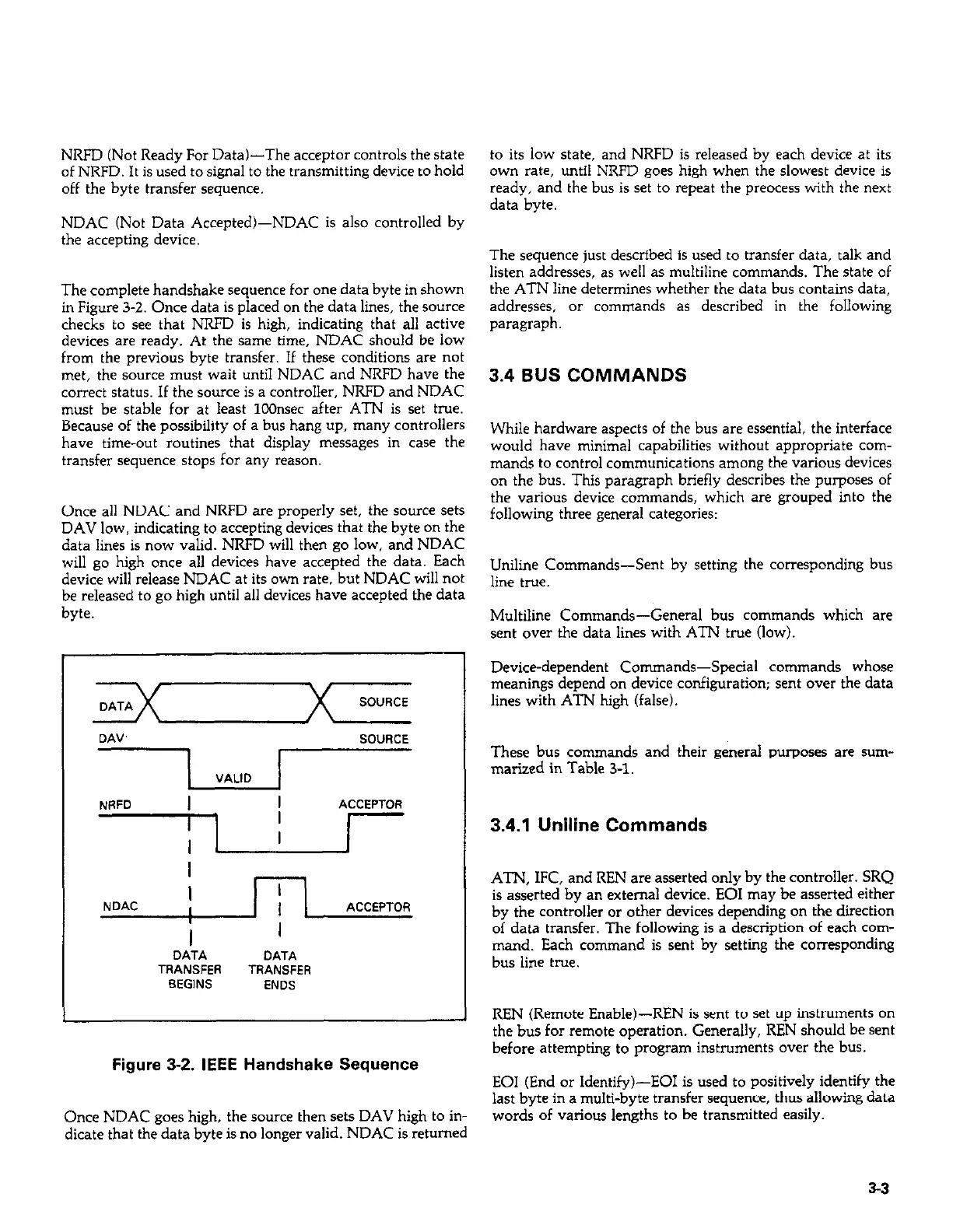NRFD (Not Ready For Data&The acceptor controls the state
of NRFD. It is used to signal to the transmitting device to hold
off the byte transfer sequence.
NDAC (Not Data Accepted)-NDAC is also controlled by
the accepting device.
The complete handshake sequence for one data byte in shown
in Figure 3-Z. Once data is placed on the data lines, the source
checks to see that NRFD is high, indicating that all active
devices are ready. At the same time, NDAC should be low
from the previous byte transfer. If these conditions are not
met, the source must wait until NDAC and NRFD have the
correct status. If the source is a controller, NRFD and NDAC
must be stable for at least 1OOnsec after ATN is set true.
Because of the possibility of a bus hang up, many controllers
have time-out routines that display messages in case the
transfer sequence stops for any reason.
Once all NDAC and NRFD are properly set, the source sets
DAV low, indicating to accepting devices that the byte on the
data lines is now valid. NRFD will the” go low, and NDAC
will go high once all devices have accepted the data. Each
device will release NDAC at its own rate, but NDAC will not
be released to go high until all devices have accepted the data
byte
DA”’
SOURCE
VALID
NRFD
ACCEPTOR
I
I
I
I
I
NDAC
I
ACCEPTOR
,
I
I
DATA
DATA
TRANSFER
TRANSFER
BEGINS
ENDS
Figure 3-2. IEEE Handshake Sequence
Once NDAC goes high, the source then sets DAV high to in-
dicate that the data byte is no longer valid. NDAC is returned
to its low state, and NRFD is released by each device at its
own rate, until NRFD goes high when the slowest device is
ready, and the bus is set to repeat the preocess with the next
data byte.
The sequence just described is used to transfer data, talk and
listen addresses, as well as multiline commands. The state of
the ATN line determines whether the data bus contains data,
addresses, or commands as described in the following
paragraph.
3.4 BUS COMMANDS
While hardware aspects of the bus are essential, the interface
would have minimal capabilities without appropriate com-
mands to control communications among the various devices
on the bus. This paragraph briefly describes the purposes of
the various device commands, which are grouped into the
following three general categories:
Uniline Commands-Sent by setting the corresponding bus
line true.
Multiline Commands-General bus commands which are
sent over the data lines with ATN true (low).
Device-dependent Commands-Special commands whose
meanings depend on device configuration; sent over the data
lines with ATN high (false).
These bus commands and their general purposes are surn-
marized in Table 3-l.
3.4.1 Uniline Commands
ATN, IFC, and REN are asserted only by the controller. SRQ
is asserted by a” external device. EOI may be asserted either
by the controller or other devices depending on the direction
of data transfer. The following is a description of each com-
mand. Each command is sent by setting the corresponding
bus line true.
REN (Remote Enable)-REN is sent to set up instruments on
the bus for remote operation. Generally, REN should be sent
before attempting to program instruments over the bus.
EOI (End or Identify&E01 is used to positively identify the
last byte in a multi-byte transfer sequence, thus allowing data
words of various lengths to be transmitted easily.
53

